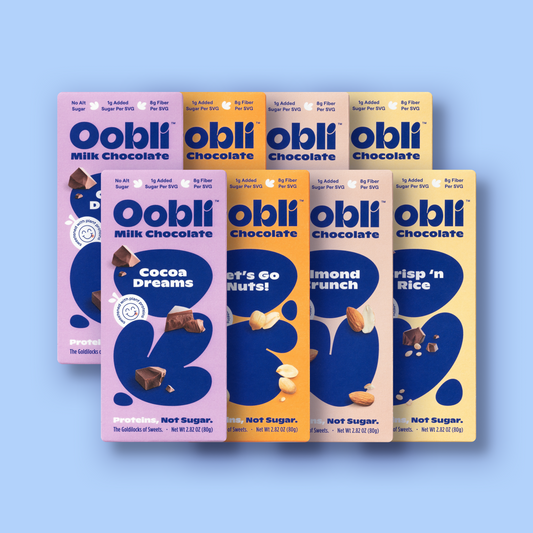In the world of sugar substitutes, stevia seemed like a shining star promising guilt-free indulgence. However, its journey to the mainstream market was far from smooth, and stevia was actually banned for use in the US by the Food and Drug Administration (FDA) in 1991.
So, why was stevia banned? And is it safe to use now, or are there better alternatives? Let's uncover the truth behind stevia as we dive into the intriguing story of why this sweetener was banned and discover stevia’s secret.
Why Was Stevia Banned?
Explaining the History of Stevia
Stevia comes from a plant native to South America, the Stevia rebaudiana plant. This natural, zero-calorie sweetener has been used for centuries by indigenous communities to sweeten their foods and drinks. It’s up to 400 times sweeter than sugar, so it really packs a punch!
In the 20th century, as artificial sweeteners really started to gain popularity, stevia was suddenly under intense scrutiny from the FDA. So, why was stevia banned?
The Health Concerns: Why Did the FDA Have Issues with Stevia?
There were some questionable studies that suggested stevia compounds were an "unsafe food additive" and prohibited its use as a sweetener in the United States, branding it as a potential risk to consumer health based on the evidence available.
Global Perspective: The Varied Treatment of Stevia Around the World
Many other countries actually embraced stevia as a natural sweetener with fewer reservations.
So why was stevia banned in the US but not everywhere else? Countries like Japan and Brazil had long-standing traditions of using stevia without reported adverse effects, leading them to approve its use as a sweetener. The specifics of stevia's regulatory status can still vary from country to country, with some limitations and restrictions on its use in certain products.
Stevia: A Natural Sweetener with Many Potential Use Cases
So, what’s the verdict on stevia today? Is the use of this divisive sweetener still regulated? Let’s take a look at how stevia use is managed in the US today.
The story of stevia in the United States took a significant turn with the introduction of the "Generally Recognized as Safe" (GRAS) status. In 2008, the FDA granted GRAS status to certain high-purity steviol glycosides, the sweet compounds found in stevia leaves.
Stevia’s GRAS designation meant that these specific forms of stevia were considered safe for consumption.
Current Status: Where Does Stevia Stand in the USA Today?
As of today, stevia is no longer banned in the United States. Stevia can now be added freely to food and beverage products.
Since the ban has been lifted, stevia is now all around us. It’s probably in your favorite sugary snack, the diet soda in your fridge, your chewing gum, granola, sports beverages, yogurt or favorite keto snack…you get the idea.
What About Other Natural Sweeteners?
Are there other promising natural sweetener alternatives? Let’s investigate.
The Problems with Other Alternative Sweeteners
There are lots of other artificial sweeteners like aspartame or sucralose. These sweeteners have also faced their fair share of criticism, as synthetic compounds that have been linked to weight gain, metabolic disorders, and even certain cancers. The lingering concerns surrounding artificial sweeteners have led many to seek a safer, more natural alternative.
Introducing Sweet Proteins: The Happiness Protein and Groundbreaking Sweetener Solution
If you haven’t heard of sweet proteins yet, don’t worry! Because sweet proteins are proteins (all other alternative sweeteners are small-molecule and affect the gut microbiome), they don't come with the potential dangerous impact on our guts and blood sugar/insulin system. They are the newest, safest, most natural guilt-free way to replace sweetness, and this is your chance to be a trailblazer and discover all the incredible benefits of sweet protein for yourself! This absolute game-changer is about to revolutionize the food and beverage industry, and we’ll all be better off because of it.
So, how are sweet proteins made? Basically, sweet proteins are naturally occurring compounds found in certain exotic fruit you’ve probably never heard of, like the oubli fruit. These proteins are incredibly powerful. They’re like sugar, but way better: They deliver up to 5,000 times the sweetness without any of the guilt or health complications! Plus, they’re natural, making them a safer option for anyone concerned about artificial sweeteners.
Can sweet proteins be used as a sugar substitute? They sure can! And that’s exactly what we’re doing at Oobli. We’ve spent years figuring out how to harness the incredible power of sweet proteins, and have now perfected our fermentation process to make guilt-free versions of the foods we love the most.
And not only that, sweet proteins work extremely well when combined with stevia. That’s what we’re up to with our partnership with Ingredion. We’re so excited about the potential of natural sweetener solutions that combine Oobli sweet proteins with stevia and other natural sweeteners.
Our delicious chocolates are vegan and keto-friendly, and contain only a handful of ingredients you probably already have in your pantry! We believe that we all deserve to enjoy sweetness, so we’re using sweet proteins to offer an entirely new way of adding a little sweetness to your day.
Try Protein-Sweetened Chocolate!
Are you curious about Oobli’s guilt-free treats? Try Oobli’s award-winning chocolates for yourself, you won’t believe what you’ve been missing!




